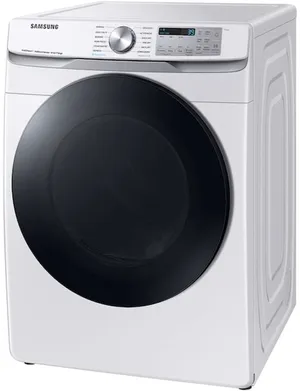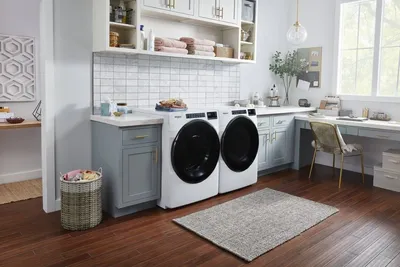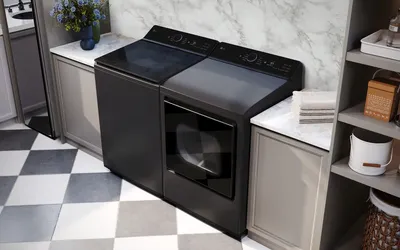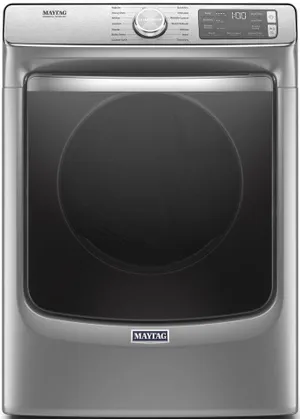
At-A-Glance
Top 5 Reasons Your Dryer Is Failing (And How to Identify the Issue)
How to Handle Dryer Repairs (or When It’s Time to Replace)
Top 5 Dryer Recommendations That Will Save the Day
Why Trust Appliance Solutions?
You toss a fresh load into the dryer, expecting warm, fluffy clothes in an hour, but instead—ugh—your clothes are still damp. Few things are more frustrating than dealing with a dryer not drying clothes, forcing you to run extra cycles or hang dry your laundry.
A malfunctioning dryer disrupts more than just laundry day. It can throw off your schedule, add stress, and make an essential household task feel impossible. Efficiently drying clothes isn’t just a convenience—it’s a necessity, especially when juggling work, kids, or weekend plans.
This blog will help you uncover why your dryer is not drying clothes, guide you through fixing common issues, and offer options if a replacement is needed. Plus, check out our product recommendations for reliable dryers that can make laundry day a breeze!
Find Your Next Washer and Dryer at Appliance Solutions
Discover excellent laundry appliance options and competitive pricing at Appliance Solutions. With one of the largest selections of washers and dryers in Tulsa, OK, we're confident you'll find the ideal fit for your laundry needs.
Laundry AppliancesTop 5 Reasons Your Dryer Is Failing (And How to Identify the Issue)
Appliances may be designed to simplify life, but even the best ones aren’t immune to wear and tear. Before you panic and start Googling for dryer not drying clothes, you might want to figure out what’s causing the hiccup. Here are the five most common culprits behind a dryer that won’t dry properly, and how to address them.
1. Clogged Venting System
Imagine trying to breathe through a straw stuffed with cotton. That’s basically what your dryer is doing if the venting system is clogged. The vent system is your dryer’s lifeline, allowing hot, moist air to escape. When lint, debris, or even small nests block it, airflow struggles, significantly lowering the efficiency of the drying process.
Signs of vent obstruction are usually pretty clear. You might notice longer drying times, an unusually hot exterior on the dryer, or excessive warmth in your laundry room. And if you’re starting to spot lint around the vent hose, it’s time to roll up your sleeves.
The solution is simple but crucial—clean the lint trap after every load and inspect the external vent regularly. You can also use vacuum attachments or special dryer vent cleaning kits for a deeper clean. Maintaining this small chore can save you from bigger headaches down the road.
Learn more: Laundry Detergents Demystified: Which Type Should You Use?
2. Faulty Heating Element
Without a properly functioning heating element, your dryer is like a hairdryer that just blows air. The heating element is responsible for producing the hot air needed to evaporate water from your clothes. Over time, wear and tear can leave it weak, cracked, or completely burnt out.
How do you know the heating element is the issue? Pay attention to what comes out of the machine. If the air feels lukewarm or downright cold, chances are the element is failing. Don’t ignore this! Running wet clothes through a cycle without heat doesn’t just waste energy—it wears down both the dryer and your patience.
Fixing this starts with inspection. Always unplug the machine before poking around inside. If you see visible damage to the heating element, it’s time for a replacement. Don’t worry; heating elements are relatively straightforward to replace. They can be purchased online or at a hardware store, often for less than the cost of a service visit.
3. Overloaded Dryer
We get it—life gets busy, and sometimes you think it’s faster to stuff all your clothes into a single load. But overloading is one of the sneaky ways you sabotage your dryer’s performance. When a dryer is packed to the brim, airflow is restricted, leading to uneven drying. You wind up with certain spots that are bone dry and others that are still damp.
The tell-tale signs? Clothes might be slightly twisted, or some items might feel wetter than others despite the dryer stopping its cycle. Worse yet, repeated overloading could strain the internal components of your machine, shortening its lifespan.
Here’s the fix—don’t overload. A good rule of thumb is to fill only about three-fourths of the drum. Not only will your clothes dry faster, but they’ll also stay wrinkle-free, saving you time on ironing.
Learn more: Washer Dryer Combos vs. Laundry Pairs: Which Is Better?
4. Broken Drum Belt
A dryer that makes a humming noise but refuses to tumble—sound familiar? That’s a classic symptom of a broken or worn drum belt. The belt wraps around the drum and motor, enabling your clothes to tumble in the rotating drum. Without it, your dryer becomes nothing more than a glorified heater.
Signs of a malfunctioning belt are obvious. Aside from the lack of movement, you may also hear a screeching or thumping sound. Open the dryer, and you might notice the belt is frayed or outright snapped.
While replacing a drum belt might sound intimidating, it’s a relatively low-cost and straightforward fix. You’ll need to refer to your manual for specific instructions, but with basic hand tools, you can have your dryer back in working order within a couple of hours.
5. Thermostat or Sensor Issues
Modern dryers are pretty smart, equipped with thermostats and moisture sensors that monitor heat levels and moisture content. If these sensors fail, your dryer may overheat, shut off mid-cycle, or stop prematurely while leaving clothes damp.
Diagnosing sensor issues can be tricky since it’s often an internal problem. However, if your clothes consistently feel damp or the dryer turns off too soon, it’s worth looking into. Many machines allow for diagnostic testing, which can help confirm whether a specific sensor is the issue.
Once confirmed, replacing a faulty sensor is the way to go. These parts are available through appliance repair stores, and while it may require some fiddling, it’s a repair many people can manage themselves after consulting the user manual.
Learn more: Tulsa Appliance Stores: Local Shopper's Guide
How to Handle Dryer Repairs (or When It’s Time to Replace)
Not every problem requires a shiny new dryer. Some dryers are like an old friend—you can keep them around by addressing minor issues. But sometimes, fixing dryer issues can cost more than replacing the whole machine. How do you decide which route to take?
Repairs are generally worth it if the fix costs less than 50% of the appliance’s current value. For instance, a broken belt or heating element repair might run you $100-$200. But if larger and pricier components, like the motor or drum, are failing, it may be more cost-effective to invest in a new electric dryer or gas dryer. Remember, even when repaired, older models can be less energy-efficient.
For those on a budget, scratch and dent dryer models are an unbeatable option. These appliances may have a cosmetic ding here or there but come with full functionality—and a fraction of the retail price tag. Plus, they’ll bring modern efficiency into your home with a reliable dryer without making your wallet cry.
If you’re in the market for savings, look for electric dryers on clearance for the best deals.
Top 5 Dryer Recommendations That Will Save the Day
When upgrading your dryer, you want a machine that’s reliable, efficient, and makes laundry day effortless. Here are five standout models that deliver on all fronts.
Amana 6.5 Cu. Ft. White Front Load Electric Dryer

(SKU NED4655EW)
Amana Front Load Electric Dryer
This no-frills dryer is perfect for those who value reliability and simplicity. Its automatic drying feature stops the cycle once clothes are dry, saving energy and protecting fabrics. With a compact design and budget-friendly price, it’s ideal for small spaces or tight budgets while still delivering consistent performance.
Samsung 7.5 Cu. Ft. Front Load Electric Dryer

(SKU DVE45B6300W)
Samsung Front Load Electric Dryer
Packed with advanced features, the Samsung dryer combines style with smarts. Its sensor dry technology adjusts drying times based on moisture levels to prevent over-drying, while the ENERGY STAR® certification means lower utility bills. The addition of a steam cycle for wrinkle reduction is a game-changer, especially for those who want clothes that look crisp straight from the dryer.
Whirlpool 7.4 Cu. Ft. Front Load Gas Dryer

(SKU WGD6605MW)
Whirlpool Front Load Gas Dryer
For families or larger households, this gas dryer’s impressive capacity and advanced moisture-sensing technology ensure even bulky loads come out dry the first time. Its touch control interface adds a modern touch, making it easy to customize cycles. Dependable and low-maintenance, it’s built for the long haul.
LG 7.3 Cu. Ft. Rear Control Gas Dryer

(SKU DLG8401BE)
This sleek model offers a stylish design and innovative features like TurboSteam technology, which eliminates wrinkles and refreshes clothes in minutes. Quiet operation ensures minimal disruption, while its energy efficiency makes it a smart choice for eco-conscious buyers.
Maytag 7.3 Cu. Ft. Front Load Electric Dryer

(SKU MED8630HC)
Maytag Front Load Electric Dryer
Durable and powerful, the Maytag dryer is designed for households with heavy laundry needs. Its extra-power function tackles damp spots effortlessly, ensuring towels and comforters dry in one go. Built with commercial-grade components, this model combines long-term reliability with modern convenience.
Each of these models caters to different needs, from budget-friendly basics to high-tech efficiency. Explore our full selection and find the perfect dryer to elevate your laundry game!
Final Thoughts
Here’s the rundown on why your dryer isn’t performing its best:
- A clogged vent restricts airflow.
- A faulty heating element eliminates heat.
- An overloaded dryer struggles with airflow.
- A broken belt stops the drum from tumbling.
- Sensor issues leave clothes damp.
Understanding these causes helps you fix minor issues or decide when it’s time for a new dryer. If you’re dealing with a dryer not drying clothes, our featured models offer durability, efficiency, and advanced technology to simplify laundry.
Browse our selection or contact our Appliance Solutions team for expert support. Make laundry day seamless!
Dryer Not Drying Clothes FAQs
How do I tell if my dryer is going bad?
Watch for extended drying times, unusual noises, or frequent repairs requiring costly parts—these are all red flags.
Why are my clothes still damp after drying?
Common causes include clogged vents, failing sensors, or an overloaded machine preventing airflow.
Why won’t my clothes dry in the dryer?
Heating element problems or a faulty thermostat could be the reason. Refer to specific sections above for details.
How often should I clean my dryer vents?
Clean the lint filter after each load and inspect vents for blockages monthly to avoid airflow issues.
How long do dryers typically last?
With proper maintenance, dryers generally last 10–13 years. Being proactive with repairs can extend their lifespan.
Why Trust Appliance Solutions of Tulsa?
Appliance Solutions of Tulsa is proud to have served greater Tulsa with the best home and outdoor appliances since 1994. From the beginning, our mantra has always been “Crazy Good Deals and Legendary Service.” We believe in delivering top-notch customer service at every stage of the buying journey. From initial product research to service after sale, we’ll be with you. Shop refrigerators, ranges, cooktops, ovens, dishwashers, washers, dryers, and more. You’ll find deals and service that other stores simply can’t match. Shop with us today!
Shop Dryers at Appliance Solutions
At Appliance Solutions of Tulsa, our focus is on the customer. Our professional team is dedicated to helping you find the best dryer — whether you call us at 918-712-0304, email us, or use our online texting feature. Visit our Tulsa appliance showroom today to experience what sets Appliance Solutions apart.